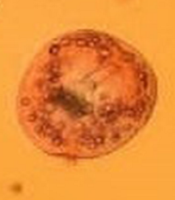Abstract
Background:
The chemical agents applied to reduce the complications of hydatid cyst surgery are not free of side effects. Formononetin (FMN), as a natural isoflavone, has been shown to have various therapeutic benefits.Objectives:
We studied the in vitro and ex vivo protoscolicidal activity and cellular mechanisms of FMN against hydatid cyst protoscoleces.Methods:
Formononetin at 75, 150, and 300 μg/mL was mixed with hydatid cyst protoscoleces (103/mL), and the viability was determined in 5 to 60 min through eosin staining assay. The effect of FMN on caspase-3 activity was tested through a commercial colorimetric protease kit. In addition, the penetrability of the plasma membrane of protoscoleces after exposure to FMN was also determined by the SYTOX assay.Results:
Formononetin at 300 μg/mL completely destroyed hydatid cyst protoscoleces after 30 minutes. While at 150 μg/mL, after 60 minutes of contact, 100% of protoscoleces were eliminated. By ex vivo assay, FMN showed its antiparasitic effect for longer periods. Based on these results, FMN at 300 μg/mL concentration completely eliminated hydatid cyst protoscoleces after 60 minutes of exposure. While at a concentration of 150 μg/mL after 60 minutes, 89.6% of protoscoleces were destroyed. Formononetin noticeably increased (P < 0.001) the activity of caspase-3 and the permeability of protoscoleces dose-dependently.Conclusions:
Formononetin as a natural product showed promising effects on the protoscoleces of hydatid cysts, indicating that it can be considered a valuable scolicidal agent. However, additional investigations are necessary to evaluate its efficacy in animal models and human subjects.Keywords
Echinococcus granulosus Scolicidal Apoptosis Plasma Membrane In Vitro and Ex Vivo
1. Background
Hydatid cyst is well-known as a parasitic disease initiated by Echinococcus granulosus from the category of cestode worms (1). Adult worms are formed by eating cyst-infected viscera and in the intestine of the dogs as the final host. Humans are the intermediate or accidental hosts of this parasite, and they become infected by consuming plants or vegetables contaminated with worm eggs or by contact with an infected dog (2). Sometimes the disease incubation period is very long, and the disease may be diagnosed 20 - 25 years after infection. Symptoms of hydatidosis depend on the cysts’ number, dimension, and site (3). There is still much controversy about treating this disease, and as a general protocol, if the cyst is solitary or confined to one area (one liver lip with one lung lip), the treatment of choice is surgery to eradicate the cysts (4). In cases where surgery is impossible, medical treatments such as albendazole and mebendazole are used (5, 6).
Today, leakage of cysts or leaks of their fillings during surgery is the most critical upset for surgeons (7, 8). The use of scolicidal agents, e.g., hypertonic salt 20% and silver nitrate (Ag-nitrate), has been considered for reducing the risk of protoscoleces spread and relapse of the disease (9), but some complications (fibrosis of biliary ducts and liver cirrhosis) have been reported with these agents (10).
Due to high availability, high efficacy, low cost, and minimum toxicity, herbs and derivatives are generally applied for treating infectious diseases, especially parasitic ones (11). Isoflavones with the chemical formula of C20H18O6 are a subset of flavonoid compounds with pharmacological benefits for human health (12, 13). Formononetin (FMN) (C16H12O4) is a natural isoflavone found in many foods belonging to the Fabaceae family (14). The chemical name of the pheromone is biochanin B, and its IUPAC name is 7-hydroxy-4’-methoxy isoflavone (14). Isoflavonoids are found in large quantities in plants such as soybeans and clover (14). Formononetin has pharmacological benefits, e.g., antimicrobial, antioxidant, anti-hyperlipidemic, anti-diabetic, anti-tumor, neuroprotective, and cardioprotective activity (14, 15).
2. Objectives
Since FMN has shown various biological and therapeutic effects, in this study, we intended to study the in vitro and ex vivo antiparasitic effect of FMN on hydatid cyst protoscoleces.
3. Methods
3.1. Chemicals
Formononetin (purity > 99%) and Eosin powder were procured from Sigma-Aldrich, Germany. Other chemicals were provided in the best grades.
3.2. Preparation of Protoscoleces
Protoscoleces were prepared from the liver of sheep infected with hydatid cysts based on the method described by Cheraghipour et al. (16).
3.3. Viability Assay
The viability of protoscoleces was evaluated by eosin staining assay according to the method described by Mahmoudvand et al. (17). Living protoscoleces were transparent and colorless, while dead protoscoleces were seen in red.
3.4. In Vitro Scolicidal Activity
In the first step, FMN concentrations of 75, 150, and 300 μg/mL were mixed with protoscoleces (1 × 103/mL), and the viability was recorded after 5 to 60 minutes in 48-chamber plates as triplicate. Consecutively, sterile normal saline + tween 20 and silver nitrate were reported as the negative and positive controls, respectively (18).
3.5. Ex vivo Scolicidal Effects
Nearly 50% of the hydatid cyst contents were drained, and various concentrations of FMN were then separately injected to fill the cyst. Then, the remaining cyst fluid was obtained for 5 - 60 minutes, and the viability of the protoscoleces was assessed by eosin staining assay (19).
3.6. Effect of Caspase-3 Activity in Protoscoleces
The activity of caspase-3 in protoscoleces after incubation with FMN was studied based on a commercial colorimetric protease kit (Sigma, Germany) according to the producer protocols (20).
3.7. Effect on the Plasma Membrane Permeability
Formononetin effect on the permeability of plasma membrane in protoscoleces was studied by the SYTOX stain approach through the Triton commercial kit (Sigma-Aldrich, Germany) after 30, 60, 120, and 240 minutes of protoscoleces treatment with FMN (19).
3.8. Statistical Analysis
Data analysis was done using SPSS version 25.0 software at P < 0.05 as a significance level.
4. Results
4.1. In Vitro Protoscolicidal Effect
Formononetin at 300 μg/mL concentration absolutely demolished hydatid cyst protoscoleces after 30 minutes of exposure (Figure 1), while at 150 μg/mL after 60 minutes, 100% of protoscoleces were eliminated. Among the studied concentrations, FMN at 75 μg/mL showed the lowest level of protoscolicidal effects, so that after 60 minutes of exposure, 67.3% of protoscoleces were destroyed. The results showed that FMN at different concentrations (75, 150, and 300 μg/mL) meaningfully declined the viability of protoscoleces compared to the control group (Figure 2).
Live (right) and dead (left) protoscoleces
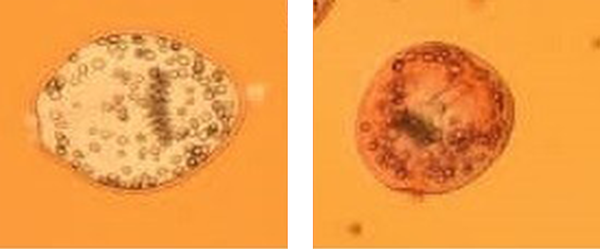
In vitro effects of formononetin (Formo) on hydatid cyst protoscoleces after 5 - 60 minutes. * P < 0.001 significant compared with the control
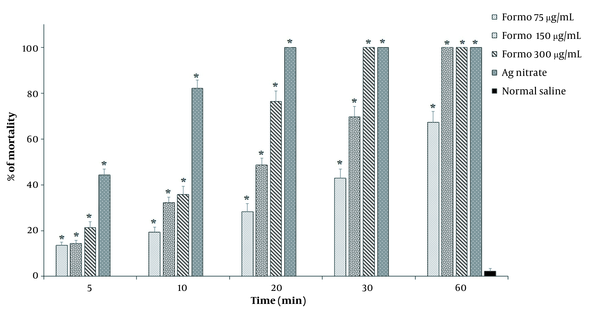
4.2. Ex Vivo Protoscolicidal Effect
Formononetin showed its antiparasitic effect for longer periods. Based on these results, FMN at 300 μg/mL concentration completely eliminated hydatid cyst protoscoleces after 60 minutes of exposure, while at 150 μg/mL after 60 minutes, 89.6% of protoscoleces were destroyed. Similar to in vitro results, it showed the lowest level of protoscolicidal effects among the studied concentrations, so after 60 minutes of exposure, it destroyed 52.6% of protoscoleces. The results showed that FMN at different concentrations (75, 150, and 300 μg/mL) significantly killed (P < 0.001) protoscoleces compared to the control group (Figure 3).
Ex vivo effects of formononetin (Formo) on hydatid cyst protoscoleces after 5 - 60 minutes. * P < 0.001 significant compared with the control
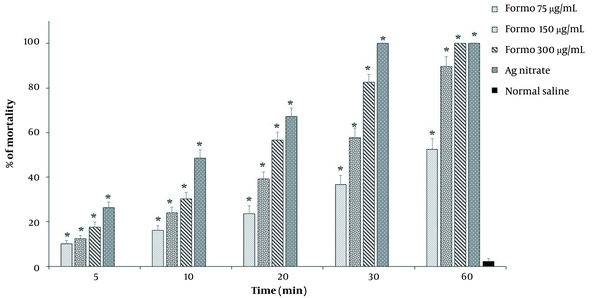
4.3. Effect on Caspase-3 Activity
Formononetin at 7.5, 15, and 30 μg/mL triggered the caspase-3 activity by 7.4%, 18.9%, and 32.7%, respectively (Figure 4).
The effects of formononetin (Formo) on the activity of caspase-3 in protoscoleces (mean ± SD). * P < 0.005 statistically different compared to the control
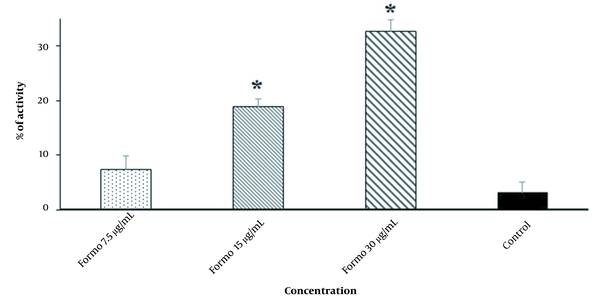
4.4. Effect of Formononetin on Permeability of Plasma Membrane
The findings displayed that the plasma membrane permeability of protoscoleces noticeably elevated after FMN treatment dose-dependently (Figure 5).
The effects of formononetin (Formo) on the plasma membrane permeability of protoscoleces (mean ± SD)
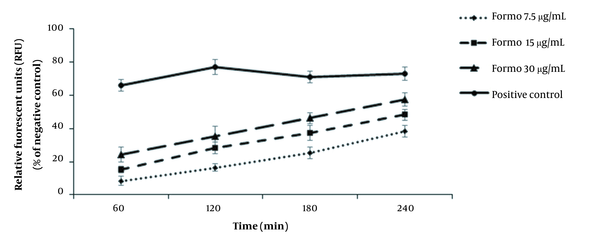
5. Discussion
Based on the obtained results, FMN, especially at 150 and 300 μg/mL, showed strong protoscolicidal effects, whereas it noticeably (P < 0.001) increased the activity of caspase-3 and permeability of protoscoleces dose-dependently. Hydatid cyst treatment is primarily done by surgery unless there is a reason. In such cases, medications are used, such as benzimidazole, albendazole, and mebendazole (8, 21). Drug treatment can only be effective for small, inactive cysts, while large and active cysts inevitably fall into surgical treatment. Surgery has a risk of cyst rupture and leakage of its internal materials and subsequent infection of adjacent organs (9, 10). Therefore, in the surgical protocol of hydatid cysts, protoscolicidal materials, e.g., silver nitrate, povidone-iodane, and 20% hypertonic salt, are mandatorily used (10). Hence, achieving efficient protoscolicidal agents with minimal side effects is necessary.
We revealed that FMN at 300 μg/mL completely destroyed hydatid cyst protoscoleces after 30 minutes, while at 150 μg/mL, after 60 minutes of contact, 100% of protoscoleces were eliminated. By ex vivo assay, FMN showed its antiparasitic effect for longer periods. Based on these results, FMN at 300 μg/mL completely eliminated hydatid cyst protoscoleces after 60 minutes of exposure, whereas, at a concentration of 150 μg/mL after 60 minutes, 89.6% of protoscoleces were destroyed. A noteworthy point in this study is that ex vivo FMN exhibited its antiparasitic effect over longer periods. This might be because some proteins, substances, and inhibitors are present in the fluid of the hydatid cyst, reducing the drug’s effectiveness.
Yang et al. reported the antimicrobial effects of FMN against Gram-positive and Gram-negative bacteria, e.g., Enterobacter cloacae, Escherichia coli, and Pseudomonas aeruginosa (22). Wang et al. revealed the antiviral effects of FMN on enterovirus-51, whereas this fraction reduced enterovirus-51 RNA and protein synthesis (23).
In another study, Lauwaet et al. showed that isoflavone FMN inhibited the adhesion, motility, and viability of Giardia lamblia trophozoites (24). Mead and McNair showed that among some tested flavonoids and isoflavone compounds (e.g., galangin, luteolin, silibinin, quercetin, genistein, apigenin, and naringenin), quercetin, apigenin, and genistein revealed the highest in vitro antiparasitic effects against Cryptosporidium parvum and Encephalitozoon intestinalis in concentrations ranging from 5.5 to 15 μM (25). Recently, Faixova et al. reported the antiparasitic effects of some isoflavones (genistein, curcumin, silymarin, and quercetin) against some flatworms, e.g., Raillietina spp., Fasciola spp., Schistosoma spp., and Echinococcus spp., through affecting the tegumental construction and disturbance in metabolism by interaction with enzymes or signaling molecules (26).
Stimulation of programmed cell death (apoptosis) as a primary mechanism of the new antimicrobial agents induced by external factors ultimately results in cell death (27). Caspases, mainly caspase-3, are recognized as essential factors of apoptosis (28). We determined that FMN at the doses of 7.5, 15, and 30 μg/mL triggered caspase-3 activity by 7.4%, 18.9%, and 32.7%, respectively, indicating that the induction of apoptosis may be suggested as a protoscolicidal mechanisms of FMN. The effect on plasma membrane permeability of microbial pathogens is another cellular mechanism in killing and eliminating pathogenic microbes (29). In the current study, we exhibited that the level of plasma membrane permeability of protoscoleces was noticeably elevated dose-dependently, although the action mechanism of FMN against protoscoleces has not yet been evaluated. However, previous studies reported that isoflavones have antimicrobial mechanisms mainly against plasma membranes and apoptosis, disrupting the lipid bilayer structure and decreasing the membrane’s electrical potential leading to the outflow of critical materials, e.g., amino acids, proteins, and ions, such as potassium and calcium, causing cell death (10-12, 30-32).
5.1. Conclusions
As a natural product, FMN showed promising effects on the protoscoleces of hydatid cysts, indicating that it can be considered a valuable scolicidal agent. However, more investigations are necessary to evaluate its efficacy in animal models and human subjects.
References
-
1.
Moro P, Schantz PM. Echinococcosis: a review. Int J Infect Dis. 2009;13(2):125-33. [PubMed ID: 18938096]. https://doi.org/10.1016/j.ijid.2008.03.037.
-
2.
Eckert J, Thompson RC. Historical Aspects of Echinococcosis. Adv Parasitol. 2017;95:1-64. [PubMed ID: 28131361]. https://doi.org/10.1016/bs.apar.2016.07.003.
-
3.
Siracusano A, Teggi A, Ortona E. Human cystic echinococcosis: old problems and new perspectives. Interdiscip Perspect Infect Dis. 2009;2009:474368. [PubMed ID: 19888428]. [PubMed Central ID: PMC2771156]. https://doi.org/10.1155/2009/474368.
-
4.
Solomon N, Fields PJ, Tamarozzi F, Brunetti E, Macpherson CNL. Expert Reliability for the World Health Organization Standardized Ultrasound Classification of Cystic Echinococcosis. Am J Trop Med Hyg. 2017;96(3):686-91. [PubMed ID: 28070008]. [PubMed Central ID: PMC5361546]. https://doi.org/10.4269/ajtmh.16-0659.
-
5.
Agudelo Higuita NI, Brunetti E, McCloskey C. Cystic Echinococcosis. J Clin Microbiol. 2016;54(3):518-23. [PubMed ID: 26677245]. [PubMed Central ID: PMC4767951]. https://doi.org/10.1128/JCM.02420-15.
-
6.
Stojkovic M, Zwahlen M, Teggi A, Vutova K, Cretu CM, Virdone R, et al. Treatment response of cystic echinococcosis to benzimidazoles: a systematic review. PLoS Negl Trop Dis. 2009;3(9). e524. [PubMed ID: 19787039]. [PubMed Central ID: PMC2745697]. https://doi.org/10.1371/journal.pntd.0000524.
-
7.
Albalawi AE, Alanazi AD, Baharvand P, Sepahvand M, Mahmoudvand H. High Potency of Organic and Inorganic Nanoparticles to Treat Cystic Echinococcosis: An Evidence-Based Review. Nanomaterials (Basel). 2020;10(12). [PubMed ID: 33348662]. [PubMed Central ID: PMC7766156]. https://doi.org/10.3390/nano10122538.
-
8.
Ya-Min G, Wen-Jun Z, Shun-Yun Z, Xiu-Min H, Zheng-Guang X. [Surgical treatment strategy for complex hepatic echinococcosis: a review]. Zhongguo Xue Xi Chong Bing Fang Zhi Za Zhi. 2018;30(6):705-8. Chinese. [PubMed ID: 30891993]. https://doi.org/10.16250/j.32.1374.2018169.
-
9.
Salimikia I, Hakami M, Shahmoradi MK. Iranian Herbal Medicines Against Hydatid Cyst Protoscoleces: A Systematic Review. Infect Disord Drug Targets. 2021;21(5). e270421188119. [PubMed ID: 33208081]. https://doi.org/10.2174/1871526520666201117145733.
-
10.
Cheraghipour K, Masoori L, Zivdari M, Beiranvand M, Malekara V, Yarahmadi V, et al. A systematic appraisal of the use of carvacrol-rich plants to treat hydatid cysts. J Parasit Dis. 2022;46(3):916-22. [PubMed ID: 36091288]. [PubMed Central ID: PMC9458781]. https://doi.org/10.1007/s12639-021-01461-3.
-
11.
Moshrefi Zenoozi Z, Soltaninezhad B, Hashemi M, Noori SMA. A review of effective essential oils and their biologically active compounds to protect the safety of food stored against insect pests. J Essent Oil Res. 2022;34(2):111-22. https://doi.org/10.1080/10412905.2022.2032420.
-
12.
Krizova L, Dadakova K, Kasparovska J, Kasparovsky T. Isoflavones. Molecules. 2019;24(6). [PubMed ID: 30893792]. [PubMed Central ID: PMC6470817]. https://doi.org/10.3390/molecules24061076.
-
13.
Zaheer K, Humayoun Akhtar M. An updated review of dietary isoflavones: Nutrition, processing, bioavailability and impacts on human health. Crit Rev Food Sci Nutr. 2017;57(6):1280-93. [PubMed ID: 26565435]. https://doi.org/10.1080/10408398.2014.989958.
-
14.
Machado Dutra J, Espitia PJP, Andrade Batista R. Formononetin: Biological effects and uses - A review. Food Chem. 2021;359:129975. [PubMed ID: 33962193]. https://doi.org/10.1016/j.foodchem.2021.129975.
-
15.
Tay KC, Tan LT, Chan CK, Hong SL, Chan KG, Yap WH, et al. Formononetin: A Review of Its Anticancer Potentials and Mechanisms. Front Pharmacol. 2019;10:820. [PubMed ID: 31402861]. [PubMed Central ID: PMC6676344]. https://doi.org/10.3389/fphar.2019.00820.
-
16.
Cheraghipour K, Beiranvand M, Zivdari M, Amiri S, Masoori L, Nourmohammadi M, et al. In vitro potential effect of Pipper longum methanolic extract against protoscolices of hydatid cysts. Exp Parasitol. 2021;221:108051. [PubMed ID: 33301754]. https://doi.org/10.1016/j.exppara.2020.108051.
-
17.
Mahmoudvand H, Kheirandish F, Ghasemi Kia M, Tavakoli Kareshk A, Yarahmadi M. Chemical composition, protoscolicidal effects and acute toxicity of Pistacia atlantica Desf. fruit extract. Nat Prod Res. 2016;30(10):1208-11. [PubMed ID: 26252652]. https://doi.org/10.1080/14786419.2015.1046868.
-
18.
Mahmoudvand H, Pakravanan M, Aflatoonian MR, Khalaf AK, Niazi M, Mirbadie SR, et al. Efficacy and safety of Curcuma longa essential oil to inactivate hydatid cyst protoscoleces. BMC Complement Altern Med. 2019;19(1):187. [PubMed ID: 31349828]. [PubMed Central ID: PMC6660933]. https://doi.org/10.1186/s12906-019-2527-3.
-
19.
Ezzatkhah F, Khalaf AK, Mahmoudvand H. Copper nanoparticles: Biosynthesis, characterization, and protoscolicidal effects alone and combined with albendazole against hydatid cyst protoscoleces. Biomed Pharmacother. 2021;136:111257. [PubMed ID: 33450495]. https://doi.org/10.1016/j.biopha.2021.111257.
-
20.
Ghasemian Yadegari J, Khudair Khalaf A, Darabi R, Mahmoudvand* H. Antiparasitic effects and cellular mechanism of Astragalus maximus chloroform extract against clinical isolates of Giardia lamblia. Res J Pharmacogn. 2022;9(3):5-13.
-
21.
Cheraghipour K, Shakib P, Sheikhian A, Moradpour K, Kalani H, Zebardastpour M, et al. In vivo and In vitro Anti-hydatidosis Effect of Garlic: A Systematic Review. Curr Drug Ther. 2022;17(1):12-6. https://doi.org/10.2174/1574885517666220207144802.
-
22.
Yang Y, Mao WJ, Li HQ, Zhu TT, Shi L, Lv P, et al. Synthesis and Biological Evaluation of 7-O-Modified Formononetin Derivatives. Research Letters in Organic Chemistry. 2008;2008:1-4. https://doi.org/10.1155/2008/209830.
-
23.
Wang H, Zhang D, Ge M, Li Z, Jiang J, Li Y. Formononetin inhibits enterovirus 71 replication by regulating COX- 2/PGE(2) expression. Virol J. 2015;12:35. [PubMed ID: 25890183]. [PubMed Central ID: PMC4351682]. https://doi.org/10.1186/s12985-015-0264-x.
-
24.
Lauwaet T, Andersen Y, Van de Ven L, Eckmann L, Gillin FD. Rapid detachment of Giardia lamblia trophozoites as a mechanism of antimicrobial action of the isoflavone formononetin. J Antimicrob Chemother. 2010;65(3):531-4. [PubMed ID: 20067984]. [PubMed Central ID: PMC2818108]. https://doi.org/10.1093/jac/dkp501.
-
25.
Mead J, McNair N. Antiparasitic activity of flavonoids and isoflavones against Cryptosporidium parvum and Encephalitozoon intestinalis. FEMS Microbiol Lett. 2006;259(1):153-7. [PubMed ID: 16684116]. https://doi.org/10.1111/j.1574-6968.2006.00263.x.
-
26.
Faixova D, Hrckova G, Macak Kubaskova T, Mudronova D. Antiparasitic Effects of Selected Isoflavones on Flatworms. Helminthologia. 2021;58(1):1-16. [PubMed ID: 33664614]. [PubMed Central ID: PMC7912234]. https://doi.org/10.2478/helm-2021-0004.
-
27.
Elmore S. Apoptosis: a review of programmed cell death. Toxicol Pathol. 2007;35(4):495-516. [PubMed ID: 17562483]. [PubMed Central ID: PMC2117903]. https://doi.org/10.1080/01926230701320337.
-
28.
Chen KW, Schroder K. Antimicrobial functions of inflammasomes. Curr Opin Microbiol. 2013;16(3):311-8. [PubMed ID: 23466299]. https://doi.org/10.1016/j.mib.2013.02.004.
-
29.
Epand RM, Walker C, Epand RF, Magarvey NA. Molecular mechanisms of membrane targeting antibiotics. Biochim Biophys Acta. 2016;1858(5):980-7. [PubMed ID: 26514603]. https://doi.org/10.1016/j.bbamem.2015.10.018.
-
30.
Peres VF, Moura DJ, Sperotto AR, Damasceno FC, Caramao EB, Zini CA, et al. Chemical composition and cytotoxic, mutagenic and genotoxic activities of the essential oil from Pipergaudichaudianum Kunth leaves. Food Chem Toxicol. 2009;47(9):2389-95. [PubMed ID: 19563855]. https://doi.org/10.1016/j.fct.2009.06.035.
-
31.
Mahmoudvand H, Pakravanan M, Kheirandish F, Jahanbakhsh S, Sepahvand M, Niazi M, et al. Efficacy and Safety Curcuma zadoaria L. to Inactivate the Hydatid Cyst Protoscoleces. Curr Clin Pharmacol. 2020;15(1):64-71. [PubMed ID: 31533603]. [PubMed Central ID: PMC7366002]. https://doi.org/10.2174/1574884714666190918155147.
-
32.
Mahmoudvand H, Mahmoudvand H, Oliaee RT, Kareshk AT, Mirbadie SR, Aflatoonian MR. In vitro Protoscolicidal Effects of Cinnamomum zeylanicum Essential Oil and Its Toxicity in Mice. Pharmacogn Mag. 2017;13(Suppl 3):S652-7. [PubMed ID: 29142428]. [PubMed Central ID: PMC5669111]. https://doi.org/10.4103/pm.pm_280_16.
